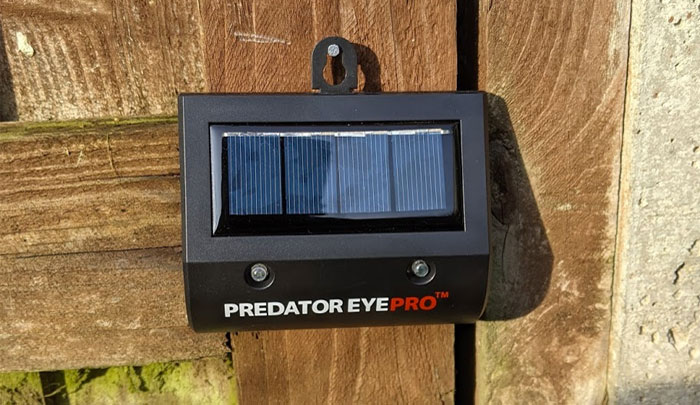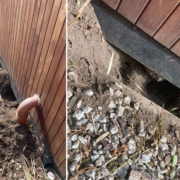How to stop foxes digging in your garden
Torn-up lawns, horizontal plants and soil strewn across the patio are just a few of the many examples of damage foxes can cause in our gardens.
It’s often hard to believe that they can be capable of so much destruction, yet digging foxes are a problem many of us have to deal with on a regular basis. And it’s incredibly frustrating!
In this article, you’ll learn why foxes do it and what action you can take to reclaim your garden and get them to stop.
Why do foxes dig in our gardens?
Looking for worms and grubs
Urban foxes are omnivores, which means they are able to eat and survive on plant or animal-based food. The fact their diet is so varied is one of the main reasons that they live so successfully among us.
Although a high proportion of an urban fox’s diet consists of waste food and handouts from humans, they actually love to catch earthworms and grubs as a quick source of protein.
They’ll do this in gardens by scratching and scraping away large areas of grass or soil to get under the surface where worms and grubs are available in abundance. It’s easy pickings for the fox but it causes havoc with our lawns and flowerbeds.
You may notice the problem gets worse after rain because the ground becomes very soft and more worms come to the surface.
Pots and boxes are also targeted because they often contain bulbs, which foxes associate with grubs and other insects.
Burying food
A bit like squirrels hoarding nuts for winter, or humans panic buying pasta during a pandemic, foxes will catch more food than they need and bury it for the future when food is scarce. They’re also clever enough to know exactly where they buried it weeks or even months later.
(If you’ve ever wondered why foxes kill all of the chickens in a coop, rather than just taking enough for a meal, this is the reason. It’s not for fun – their plan would be to come back and bury each chicken in a different location for retrieval later.)
Foxes like to place earth or undergrowth back over their buried food in order to disguise it from birds and other foxes, which is fine in the country but makes a mess of your garden.
If you notice a patch of soil that’s been displaced or turned over, rather than an outright hole, it could be a sign the fox using is your garden as a larder.
Unburying dead pets
Foxes aren’t beyond digging up dearly departed pets either, as their excellent sense of smell allows them to detect a scent up to 45cm below the surface.
Anyone who’s seen the remains of Flopsy the Rabbit or Squeak the Guinea Pig re-emerge on the lawn several months after saying goodbye will attest to it being a very upsetting experience.
Unfortunately, this isn’t a rare occurrence.
Dens, earths and boltholes
Foxes are very well-prepared when it comes to their living arrangements. A basic fox earth (or den) consists of a tunnel leading to a wider excavated chamber, but can often be much more complicated with multiple entry and exit points.
Rural foxes often dig these from scratch, but urban foxes will make the most of ready-made dens like under decking, sheds or garages, customising them with extra digging when required.
Another thing to note is that foxes often have several hidey-holes to escape to if their main den becomes compromised. So if you’ve ever noticed a fox digging a deep hole in your garden, but then not using it, the hole could be its Plan B.
Similarly, holes dug under fences or walls are often created in case the vixen needs an easy way to escape with her cubs.
Sometimes, holes are caused by cubs practising their digging skills, encouraged by the vixens in preparation for becoming independent.
What can you do to stop foxes digging?
When setting out to stop the digging in your garden, it’s helpful to look around and see what you can do to make your garden less attractive to foxes.
If you can remove temptations, make access more difficult and generally create an atmosphere that causes a fox to feel nervous about coming into your garden, you’re on the right track to stopping the devastation.
The following deterrent products give foxes several reasons to reduce their interest in your garden and stop the digging in slightly different ways. Which ones you choose will depend on the nature and scale of your problem.
Although successful fox deterrence is not an exact science, using more than one type of deterrent usually gets more effective results. Urban foxes are persistent creatures that don’t give up easily, so showing them in several different ways that your garden is no longer a safe haven really helps to force change in their behaviour.
Dig Stopper Prickle Strips
For protecting potted plants, flowerbeds, vegetable patches, seedlings and other areas of open soil, an instantly effective solution is to lay down some DigStopper Prickle Strips [aff].
Prickle strips are rows of meshed plastic spikes that you roll out on top of your soil to protect the plants or seedlings underneath.
The meshing is wide enough to allow plants to grow up through them, but not so wide that foxes can avoid stepping on the spikes. While not sharp enough to cause foxes, pets or wildlife injury, the sensation of the spikes pressing into a fox’s paw pads does make them too uncomfortable to walk or dig on.
The strips come in rolls measuring 2m x 28cm (79″ x 11″) when laid out flat. They’re easy to cut with scissors if you need to make them smaller (e.g. for pots, boxes or oddly-shaped areas), or if you need to fit them around already-established plants. It’s a good idea to measure the area you want to protect first to work how many rolls you’ll need.
Fixing pins are included, but you’ll probably find that using metal tent pegs [aff] hammered in with a camping mallet [aff] will anchor the strips into the ground much more securely, guarding against being dislodged by inquisitive foxes.
If you’re looking for a simple solution for stopping fox damage in your garden then DigStopper Prickle Strips are an easy and effective way to do it.
FOXWatch Ultrasonic Deterrent
If foxes are ripping up large chunks of your lawn, then you may need to look beyond prickle strips in favour of a solution that puts off foxes from coming into your garden altogether.
The FOXWatch Ultrasonic Deterrent is a small, weatherproof unit that sits in your garden letting off blasts of high-pitched noise each time a fox crosses its motion sensor.
These noises are too high for humans to hear but are very irritating to foxes. The repeated exposure to these irritating noises effectively trains the foxes to associate your garden with the irritation. This results in foxes reducing their visits and the time they spend in your garden.
The FOXWatch provides a convenient and effective long term solution for deterring foxes as it is left on all the time without ongoing input from you. You just need to position it in your garden (ideally facing the point the foxes come in) and switch it on.
And because deterring foxes is not something that happens overnight, the FOXWatch provides the consistency needed to gradually teach foxes to change their behaviour and stay out of your garden, regardless of the time of day or the state of the weather.
If you’re looking for a low-maintenance way of stopping the damage and reducing fox activity in your garden, the FOXWatch is a helpful device for doing it.
Scoot Fox Repellent
If you prefer to be more hands-on with protecting your garden, then the scent-based, Scoot Fox Repellent [aff] is an easy-to-use deterrent that takes advantage of the way foxes protect their territories.
Foxes spray urine to scent-mark their territories and send messages to other foxes that the area is occupied. Scoot works by introducing a new scent to your garden and tricking the fox into thinking a rival is trying to muscle in and take over. Continued reapplication leads to the fox accepting defeat and moving on elsewhere.
Scoot is a powder that comes in sachets of 50g, with two sachets to a pack. Each sachet should be diluted with water (minimum 2.5 litres, maximum 9 litres) and sprayed on the areas where digging and fouling have occurred, as well as around the fox’s entry point to your garden. Using a pump action pressure sprayer [aff] is a good way of distributing the Scoot solution evenly and accurately to the hotspot areas.
It’s important to note that spraying Scoot will often initiate a short ‘scent war’ between the fox and its supposed rival. This involves the fox urinating more than usual in a desperate attempt to reestablish control of your garden, but thankfully this doesn’t last long provided you continue to spray the Scoot. Ideally you should spray it every 2 or 3 days for a couple of weeks, as it’s through the repetition and constant renewal of the scent that you convince the fox it’s lost the battle.
Scoot is pet and plant friendly, but needs to be sprayed in the dry and then reapplied after heavy rainfall to maintain the concentration of the scent. For this reason, and the fact you need to outlast the fox in the scent war, you’ll probably find you need several packs of Scoot to achieve the desired results.
Aspectek Predator Eye Pro Lights
The Aspectek Predator Eye Pro [aff] is a very simple visual deterrent to use in your battle with digging foxes.
Each unit contains two flashing red ‘eyes’ (actually LEDs) that gives the impression the fox is being watched by another animal. In order to avoid a potential confrontation, the fox will feel reluctant to spend any length of time in your garden, especially not doing something as labour-intensive as digging holes.
Because the flashing LEDs are supposed to replicate eyes, the Predator Eye Pro should be hung on a fence or wall no higher than 20 – 40cm (10 – 16″) off the ground, which is around head height for a fox.
As these units charge during the day, via the in-built solar panel, the lights only start flashing at dusk, once the light drops below a certain level. Therefore, the Predator Eye Pro should be considered as a supplementary deterrent to the others, rather than the only solution you use.
However, they do actually look quite menacing when they come on and are virtually maintenance-free, making them a very convenient method for reducing the amount of time foxes spend in your garden at night. FYI, they also deter cats too.
Conclusion: Take action to break the fox’s habits
Foxes have got into the habit of coming into your garden unchallenged and digging to their heart’s content. Hopefully this guide has provided some ideas to stop it.
If nothing changes in your garden, the foxes will have no reason to stop coming in and wreaking the havoc that’s caused you so much frustration.
But by introducing a combination of deterrents, you’ll help to break this pattern of behaviour and gradually teach the foxes that your garden is no longer a place they can feel comfortable.
The more they feel wary or unsafe, the less time they are going to spend in your garden destroying your lawn or plants.
It doesn’t happen overnight, but stopping foxes digging up your garden is very achievable as long as you are willing to be persistent, consistent and utilise the right tools for the job.
Resources
Some of the links on this page may contain affiliate links (aff), which means we receive a commission (at no extra cost to you) if you use that link to make a purchase. It helps to keep this website running. Thank you!
- The FOXWatch Ultrasonic Deterrent
- DigStopper Prickle Strips [aff]
- Scoot Fox Repellent [aff]
- Aspectek Predator Eye Pro [aff]
- Metal Tent Pegs [aff]
- Camping Mallet [aff]
- Pump-action Pressure Sprayer [aff]






 Photo credit: John Ondreasz - Pixabay
Photo credit: John Ondreasz - Pixabay Photo credit: Victoria, Hampshire
Photo credit: Victoria, Hampshire Photo credit: Concept Research
Photo credit: Concept Research





